Viscum, Mistletoe, Sang Ji Sheng 桑寄生Viscus (Latin)Sang Ji Sheng (Mulberry Mistletoe, Loranthus [Taxillus] spp. TCM); Hu Ji Sheng (Northern Mistletoe, Viscum spp., TCM) |

|
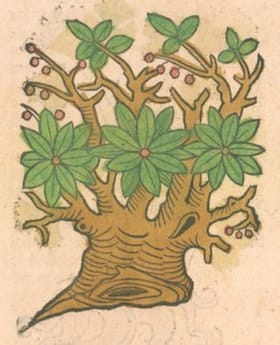 Ortus Sanitatis, Meydenbach, 1491
Ortus Sanitatis, Meydenbach, 1491 |
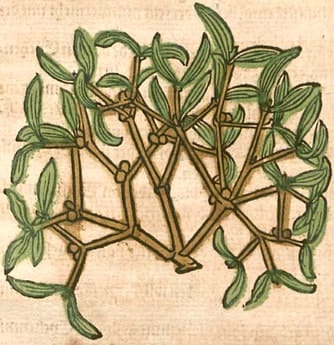 Krauterbuch, Lonitzer, 1578
Krauterbuch, Lonitzer, 1578 |
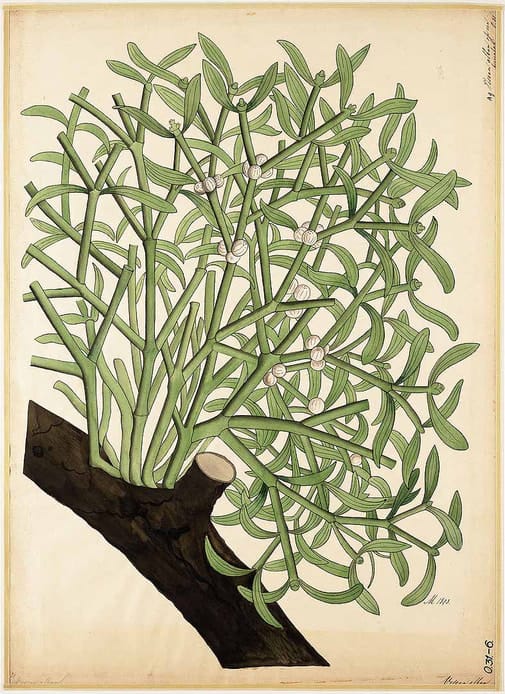 Viscum
ViscumBotanische wandplaten, 1904–1914
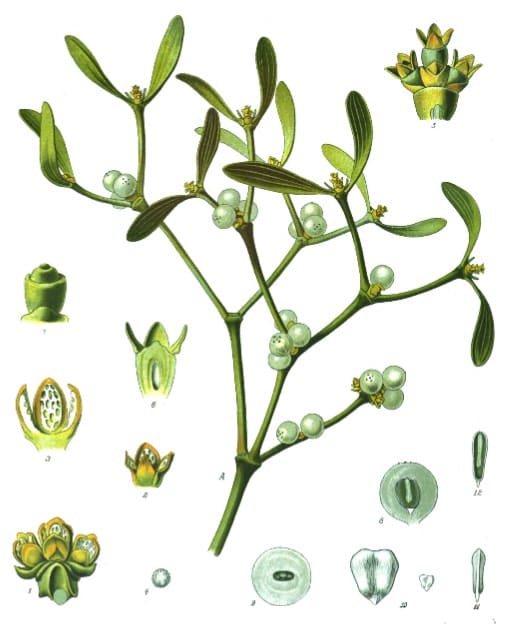
|
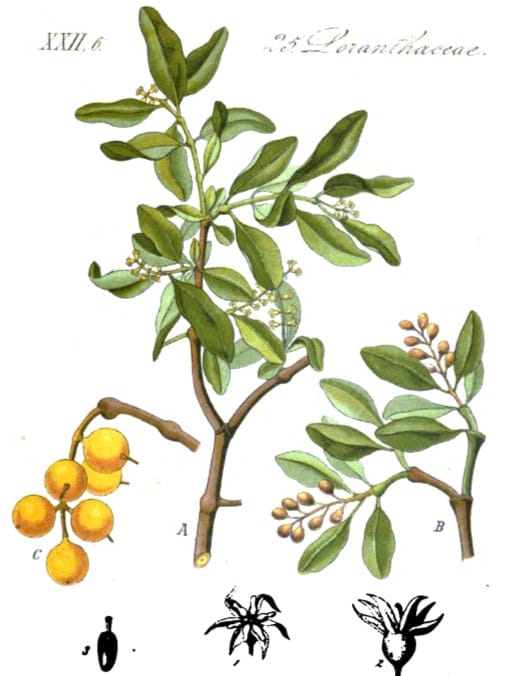
|
|
Viscum album Koehler’s Medizinal Pflanzen, 1887 |
Loranthus europeaus Flora von Deutschland (27), Kohler, 1886 |
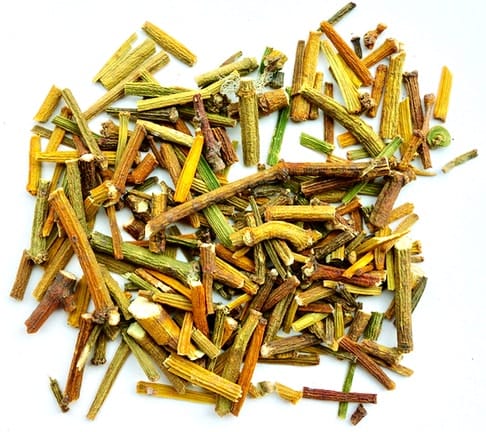 Viscum (Adam, 2017)
Viscum (Adam, 2017) Members CLICK HERE for the PRO VERSION
Members CLICK HERE for the PRO VERSIONBotanical name:
Viscum album
Loranthus parasiticus (syn. Taxillus chinensis, L. chinensis, Scurrula parasiticus) is the primary source used in TCM; however both V. coloratum and V. album are also used in parts of China.
Parts used:
Leaf and young Twigs; in TCM the whole plant including the wood is used.
Temperature & Taste:
Neutral, Bitter, Sweet.
Classifications:
2I. ANTISPASMODIC. 2L. EMOLLIENT. 2U. SUPPURATIVE
3M. ARTHRITIC
4j. NERVINE
Uses:
EUROPEAN MISTLETOE:
1. Nourishes the Liver, Calms Wind, Stops Spasms:
-Headache, Dizziness and Vertigo, as well as red eyes and face, irritability and anger
-Epilepsy and other convulsive disorders, Apoplexy, Paralysis, Hysteria, Delirium, Neuralgia and nervous debility.
-more recently for Hypertension
2. Benefits and Regulates the Heart, Stops Wind:
-Hypertension, Arteriosclerosis, and coronary Heart diseases where it can often bring a complete cure
-also used for Tachycardia, and has been used as a tonic for feeble Heart action.
3. Tonifies the Liver and Kidneys, Benefits the Tendons and Bones:
-European Mistle has been used as the Chinese in this respect; chronic Joint disease, Arthritis and Rheumatism
-“Viscum album, even in minute doses, stands as a prince among pain-subduing medicines, especially paroxysms of tearing and rending pains, rheumatic and neuralgic.… A master remedy for Sciatica” (The medical genius, Jones, 1887)
-degenerative joint diseases of the elderly
4. Stops Bleeding:
-internal bleeding; Menorrhagia
-Hemorrhage associated with blood congestion.
5. Moves the Blood, Nourishes the Uterus:
-Dymenorrhea with spasm and pain
-V. articulatum fresh herb is made into a paste from which pills are made and used for Infertility in India
-blood stasis of the lower abdomen with Menorrhagia, or Irregular Uterine Bleeding. Some used it instead of Ergot.
6. Moves the Blood, Clears Toxic Swellings:
–Celsus (150 AD) listed it for Tumors.
-dissolvent and removes thick fluids from the deeper parts of the body; it dissolves cold swellings (Avicenna)
-used as a traditional remedy for Cancer; modern research has found anti-cancer actions demonstrated in animals.
7. Externally:
-the Berries (or preparations of them) may be used externally for stiff and painful joints, and various swellings.
-The wood of the Mistle was carved into balls and worn around the neck or wrist to protect Children from Epilepsy and Convulsions
-A little of the wood, or a cross of the Wood of Mistle of the Oak was held over the afflicted part in cramps and convulsions.
CHINESE MISTLETOE:
1. Tonifies the Liver and Kidneys, Benefits the Tendons and Bones:
-lower back and knee pain, joint pain, as well as numbness and weakness of the Tendons, Ligaments, or Bones.
-Osteo-arthritis, Rheumatoid Arthritis an related conditions; effective for Wind-Damp disorders of the Joints, as well as degenerative changes occurring due to old age.
2. Calms the Fetus, Nourishes the Womb:
-Restlessness of the Fetus and Uterine bleeding during pregnancy. Said to stabilise the Embryo.
3. Nourish the Blood:
-improves the skin; used for dry, scaly Skin from weak or deficient blood.
-nourishes the Hair.
4. Stops Wind:
-Recently used successfully for Hypertension and Arteriosclerosis.
5. Promotes Milk. (V. coloratum)
-promotes Milk production
Dose:
Powder: 1–3 grams;
Comment:
… available in PRO version
Preparation:
… available in PRO version

Main Combinations:
Mistletoe & Peony
1. Wind disorders:
i. In the Western Tradition Mistletoe is most commonly combined with Peony root for all types of Internal Wind disorders including Epilepsy, Apoplexy, Dizziness, Vertigo, Migraine
ii. Mistletoe with … available in PRO version
iii. Mistletoe with … available in PRO version
2. Epilepsy:
i. Mistletoe with … available in PRO version
ii. Mistletoe with … available in PRO version
3. Childhood Convulsions:
i. Mistletoe with … available in PRO version
4. Vertigo:
i. Mistletoe with … available in PRO version
ii. Mistletoe with … available in PRO version
iii. Mistletoe with … available in PRO version
5. Apoplexy:
i. Mistletoe with … available in PRO version
6. Meniere’s Disease, Mistletoe with … available in PRO version
7. Heart tonic:
i. Mistletoe with … available in PRO version
ii. for the aging Heart, Mistletoe with … available in PRO version
8. Hypertension:
i. Mistletoe with … available in PRO version
ii. Mistletoe with … available in PRO version
9. Arteriosclerosis:
i. Mistletoe with … available in PRO version
ii. Mistletoe with … available in PRO version
10. Arthritis:
i. Mistletoe with … available in PRO version
ii. Mistletoe with … available in PRO version
iii. Mistletoe with … available in PRO version
11. Threatened Miscarriage, Chinese Mistletoe (Sang Ji Sheng) with … available in PRO version
Major Formulas:
Cephalic Decoction (Charras)
Powder of Mistletoe and Peony (Gabelhover)
Powder of Mistletoes (Gabelhover)
Powder for Childhood Convulsions
Powder for Cancerous Ulcers (Gabelhover)
Electuary for the Head (Lewis)
Tian Ma Gou Teng Yin
Du Huo Ji Sheng Tang
Cautions:
1. For safety, it is better to only use Chinese Mistletoe Sang Ji Sheng during pregnancy for Threatened Miscarriage
2. Avoid overdoses.
3. The American Mistletoe Phoradendron flavescens is not suitable for use as Loranthus or Viscum.
